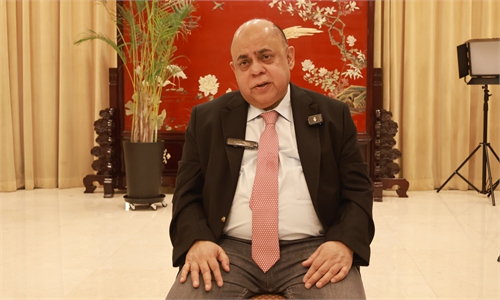
Illustration: Liu Rui/GT
A recently released tourism development plan from Xinjiang has drawn media attention. The plan aims to host more than 400 million annual visits and generate 1 trillion yuan ($140 billion) in revenue by 2030. According to a report by the South China Morning Post on Tuesday, Xinjiang plans to open up to more foreign visitors, as the local government strives to boost tourism and diversify regional economy.
For years, some Western countries have repeatedly spread false narratives to smear China's Xinjiang region. Certain Western media outlets and politicians have fabricated lies such as "forced labor" and "genocide," which have, to some extent, shaped negative impressions of Xinjiang among foreigners unfamiliar with the reality. However, as the "China Travel" trend gains traction across global social media platforms, Xinjiang has also emerged as a popular destination among international tourists seeking to explore and share their experiences.
According to multiple media reports, cross-border tourism in Xinjiang is growing rapidly. Last year, the region welcomed over 5 million visits from outside the Chinese mainland, an increase of 46 percent year on year. International travelers spent nearly $4.5 billion in Xinjiang last year, nearly three times as much as in 2023. These tourism figures serve as a testament to the region's steady development.
With the continued advancement of Belt and Road Cooperation, Xinjiang is no longer a remote border region but has become a central hub and a key gateway. Large industrial parks and economic cooperation zones are rapidly emerging, while the rural revitalization strategy is taking root across the region. The growth of the tourism sector is allowing international visitors to witness these achievements.
Jason RB Smith, host of Youtube channel The Bridge to China, has visited several cities in Xinjiang. He told the Global Times, "World's biggest solar farm comes online in Xinjiang, as well as projects to green the desert perimeters - an act done at scales the world has never before seen." To foreign visitors, Xinjiang - which is rapidly developing - is becoming a place where the modern and the ancient meet.
The current tourism boom also reflects that an increasing number of foreign visitors are approaching Xinjiang with open minds and a genuine desire to see and assess the truth for themselves.
Xinjiang has long been embracing friends from around the world with an inclusive and welcoming spirit. However, some Western media outlets and politicians, driven by ideological bias and geopolitical motives, have blatantly ignored basic facts. They have deliberately distorted Xinjiang's history and reality, fabricating sensational lies to discredit the government. Now, with China's visa-free policy in place and the "China Travel" trend going viral globally, more and more foreigners are visiting Xinjiang - only to find that the reality in China is completely different from the narratives shaped by certain Western politicians and media.
Smith told the Global Times that once one has been to Xinjiang, one understands that this vivid vision of ethnic harmony is what other nations should emulate for cultural diversity.
"Whereas the West merely accepts tolerance for cultural difference, Xinjiang and the rest of China demonstrate a genuine celebration and preservation of ethnic minority cultures."
The ambitious goal to host more than 400 million annual visits by 2030 is a microcosm of Xinjiang's high-quality development and a testament to its efforts toward opening-up. With Xinjiang's further opening-up and China's ongoing improvements in visa policies and other measures facilitating international travel, visiting Xinjiang will become increasingly seamless for foreign tourists. In the future, the booming "Xinjiang Travel" trend will open a window for the world to better understand the truth about Xinjiang.


